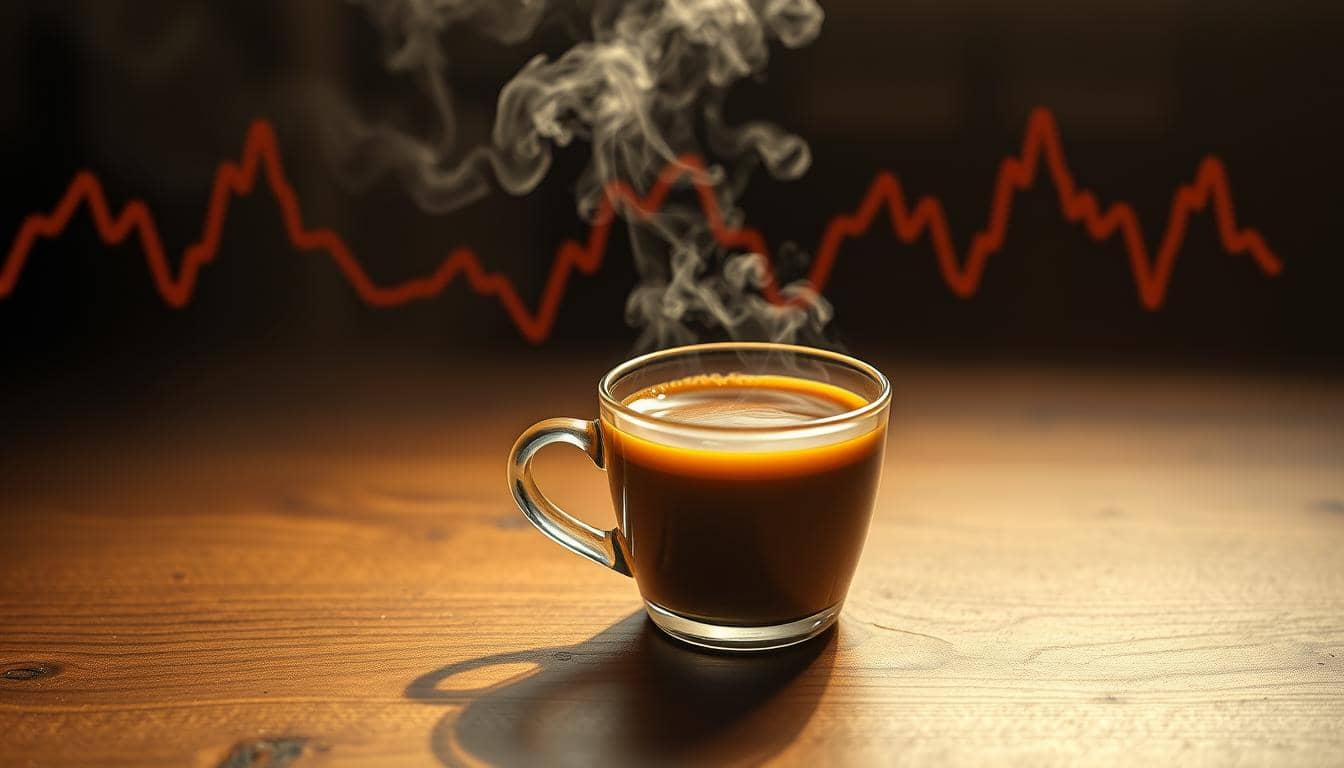Arabica coffee beans hit a staggering $4.30 per pound in February 2025—more than double their price just 12 months earlier. For coffee drinkers, this means that ground coffee now costs up to $7 a pound, a 75% jump since 2020. The surge isn’t just a blip; experts warn prices could climb another 25% this year. From droughts in Brazil to shipping bottlenecks in the Red Sea, the factors behind the coffee prices crisis are as complex as they are urgent.
Whether you’re buying beans or ordering lattes, the coffee price increase hits wallets everywhere. This article breaks down why your daily brew costs more—and what’s in store next. We’ll explore weather disasters, supply chain snarls, and shifting global demand driving this historic spike.
Key Takeaways
- Arabica bean prices hit $4.30/pound in 2025, doubling since early 2024.
- Retail coffee prices hit $7/pound, a 75% rise since 2020.
- Climate disasters damaged 20% of Brazil’s arabica crops in 2024.
- Supply chain delays blocked 5 billion coffee bags from reaching Europe by late 2024.
- Global demand from China and other markets is pushing prices higher.
From farm to cup, every link in the supply chain is under pressure. This article dives into the causes behind the record-breaking coffee prices and what they mean for your morning routine.
Introduction
Every morning, the smell of coffee is part of millions of routines. But today, that ritual comes with a heavier price tag. Coffee inflation isn’t just a blip—it’s a trend shaping how we consume one of the world’s most traded commodities. Arabica beans hit $3.48 per pound in early 2025, a 79% jump from 2024.
This surge echoes past crises, like the 1977 crisis when prices spiked to $15.34 in today’s dollars. It triggered a 15% drop in U.S. consumption.
“Bean prices could climb 25% this year.” – Andrea Illy, chairman of Illycaffè
What makes cost of coffee unique? Unlike other groceries, there’s no easy swap for caffeine. For many, it’s an essential, not a luxury. Even as prices rise, demand holds steady.
Brazil, the world’s top producer with 39% of global output, faces climate risks that ripple worldwide. From Colombia to Vietnam, the five top-producing nations control 65% of supply, making the market fragile.
The Global Coffee Supply Chain
Every cup of coffee has a story behind it. It connects farmers, exporters, and consumers all over the world. The coffee economy starts in places like Brazil, which grows 35% of the world’s coffee. Vietnam is the top supplier of robusta beans.
These beans travel long distances to U.S. ports. There, they are roasted, packaged, and sold. Each step in this journey affects the coffee prices we pay at cafes and stores.
- Brazil’s frost in 2023 cut yields, reducing global supply by millions of bags.
- China’s coffee use has grown 150% in a decade, putting pressure on supply.
- Higher transport and labor costs raise prices by 15-20% at retail.
“Price swings aren’t just about beans—it’s about fair value for all,” says a sustainable sourcing expert at the International Coffee Organization.
In 2024, coffee prices reached their highest in 13 years. This shows how fragile the system is. But, there are ways to fix it. Better partnerships, clear prices, and supporting climate-resilient farming can help. These steps could make your morning coffee more affordable.
Factors Driving Coffee Price Increases
Many factors are causing coffee prices to soar. Climate disasters, shipping delays, and currency changes are affecting the coffee economy. These factors are making coffee more expensive, impacting everyone from growers to consumers.
Climate Change Effects
Extreme weather is hurting coffee farms. Brazil’s 2024 drought and frost destroyed crops, while Vietnam faced floods and droughts. Arabica beans in Brazil fell 7.4%, and Vietnam’s exports dropped 40% last year.
Rising temperatures also spread pests to new areas. This forces farmers to use more pesticides, increasing costs.
- 2024 Brazilian drought cut arabica harvest by 7.4% (International Coffee Organization)
- Vietnam’s December exports fell 40% year-over-year
- Warmer temps let coffee rust spread to high-altitude farms
Supply Chain Disruptions
Shipping problems are adding to the coffee inflation issue. The Red Sea conflict made ships take longer routes, costing more than $100k. This left 5 billion coffee bags stuck, raising prices.
Pandemic-era port backups are still affecting shipping.
- Red Sea reroutes add 2-3 weeks to delivery times
- 5 billion bags delayed in global supply chains (ICO data)
- Container shortages in top exporting nations persist
Currency Fluctuations
Currency changes are also increasing coffee prices. A stronger US dollar hurts farmers paid in dollars. Tariff threats and rising fuel and fertilizer costs also cut into profits.
- USD strength reduces farmer profits by 15-20% in 2024
- Threat of 25% Colombia tariffs looms over markets
- Input costs for farms rose 30% since 2023
How Higher Coffee Prices Impact Consumers
When you step into a café or grocery store, the cost of coffee is more noticeable than ever. Ground coffee now costs $7 per pound, a 75% increase since 2020. This rise affects more than just the price of lattes; it changes our daily lives and budgets.
Retailers are raising prices, making drip coffee $0.18 per cup, up from $0.12 in 2021. Instant coffee prices jumped 7.1% year-over-year. But for many, the real impact is felt:
- Portion sizes shrink: Cafés cut down on espresso shots or use cheaper beans to keep prices low.
- Quality trade-offs: Cheaper brands might use more robusta beans, changing the taste.
- Weekly budgets strain: Drinking two cups a day now costs $135 more each year than in 2021.
People are finding ways to save: Home brewing becomes more popular, and specialty drinks are seen as treats. But experts say this is just the beginning. “The coffee price increase will keep going up through 2025,” an analyst predicts, citing crop drops in Brazil and Vietnam.
“Budget-conscious drinkers are cutting back—some switch to tea, others brew larger batches at home.”
With global prices up 38.8% in 2024, the effects are clear. Even small choices, like buying in bulk or choosing generic brands, show the new reality. The cost of coffee is more than a barista’s worry—it’s a daily financial choice for millions.
What Coffee Shops Are Doing to Adapt
Coffee shops across the country are changing how they work to deal with the coffee economy changes. With coffee prices going up, they’re finding new ways to keep quality high. “Uncertainty in global trade drives volatility,” says Dan Gardner of Trade Facilitators. “We’re seeing shops trying everything to stay afloat,” adds Heather Perry of Klatch Coffee.
“When President Trump even makes threats about tariffs, the minute you introduce uncertainty into a global trade system, and that’s what global trade is, things are going to get a little crazy,” Dan Gardner, president of Trade Facilitators, shared with CNN.
“Coffee prices continue to blow us away, and they continue to break record after record,” Heather Perry, CEO of Klatch Coffee and a U.S. Barista Champion, says, adding that they can’t find one “obvious cause” of the price increases.
Many shops are:
- Expanding food and retail items to boost margins
- Partnering directly with farmers for fixed-price bean contracts
- Introducing subscription programs to secure repeat customers
- Upgrading equipment to reduce waste and cut labor costs
Menu engineering is getting precise. A latte priced at $4.00 has ingredient costs at $1.50, keeping food costs at 37.5%—a balance between affordability and profit. Shops apply an average 80% markup on coffee, ensuring each cup contributes to revenue.
Future shops will likely focus on efficiency. They might have 2×2 meter micro-cafés with robotic baristas and drone deliveries. Sustainable practices like biodegradable packaging and solar power aim to cut long-term costs. Labor costs must stay within 35-45% of revenue, pushing automation for tasks like brewing and order prep.
Transparency is key. Shops explain price hikes as investments in quality and sustainability, ensuring customers understand the changes. These moves help businesses stay afloat while keeping their core mission: great coffee amid turbulent times.
The Future of Coffee Prices
Coffee inflation is changing how we enjoy our daily coffee. Experts say the rise in coffee prices is here to stay. Thaleon Tremain of Pachamama Coffee notes, “Supply is not meeting demand.” Volcafe also predicts a 25% drop in Arabica production by 2025.
“Over time, we’re going to see much higher prices,” says Tremain. He points out how climate changes are reducing areas where coffee can grow.
Rising temperatures and unpredictable weather are making less land suitable for coffee farming. Studies suggest up to 50% of current areas could become unsuitable by 2050. At the same time, demand is increasing, mainly in countries like China and Vietnam. This imbalance could lead to coffee prices rising another 25% by 2029.
- Arabica costs have surged 70% in a year, hitting historic highs.
- Robusta prices doubled in 2023, pushing instant coffee up 7% in stores.
- Brazil’s 2023 drought slashed harvests, worsening global shortages.
Technology offers hope: drought-resistant beans and vertical farming could help stabilize supplies. But these solutions take years to implement. For now, every cup of coffee costs more. Brands like Starbucks are stockpiling beans, and retailers like J.M. Smucker have already raised prices twice this year.
As climate patterns change and demand grows, cheap coffee is becoming a thing of the past. Expect coffee prices to remain volatile, with inflation making each sip more expensive. The future of coffee is not just bitter—it’s getting pricey.
How to Save Money on Coffee
As the cost of coffee keeps going up, many are looking for ways to save. We’ll look at simple tips to cut costs without giving up your daily coffee.
“The big advantage we still have is coffee is still cheaper than a cocktail,” said industry expert Perry.
Begin by making coffee at home. A daily café latte costs $5, which is $1,200 a year. Making it at home can save you over $1,000 annually. Here’s how:
- Buy whole bean coffee: It’s often cheaper and stays fresher longer than pre-ground.
- Opt for store brands like Folgers or Cafe Bustelo during BOGO sales. Bulk purchases cut per-cup costs.
- Adjust ratios. Use 2 teaspoons of grounds per cup instead of the standard tablespoon—saving 25% on coffee usage.
- Reuse grounds once for a second brew, adding fresh grounds to boost flavor.
Invest in durable tools like permanent filters, which last longer than disposable ones. Dark roast beans need less than light roasts, stretching your budget. Mix premium beans with budget options for balanced flavor without overspending.
When you go to the café, order the smallest sizes and use reusable cups. Some places give a 10-cent discount for this. Choose homemade syrups and oat milk to avoid expensive additives. Making these small changes can save you $1,354 a year compared to buying coffee every day. These small steps help protect your wallet without sacrificing the joy of coffee in the coffee economy.
Conclusion: What to Expect Moving Forward
The coffee price increase trend is here to stay. Prices could hit $3.30 per pound by 2025, with a 6.2% annual growth rate. This change is not just about money; it’s changing how we see coffee.
Market ups and downs are big factors. Prices have jumped every 2-3 years before, and now they’re higher than expected. This shows we need stable supply chains. Global production is now more than consumption for the first time since 2020-21.
U.S. imports from Colombia have dropped 16% in recent years. This shows we’re relying more on Brazil’s growing exports.
Consumers are changing their habits. More than half of Americans choose specialty coffee every week, a 7.5% increase from last year. Ground coffee sales have dropped 15.7% since 2021, but premium and flavored options are gaining fans. This shows people care more about where their coffee comes from.
Producers have tough decisions to make. Higher prices could help fund sustainable farming and fair wages if demand stays up. The U.S. market’s 65% price rise since 2021 and tight inventories show the delicate balance between supply and demand.
For coffee lovers, staying informed is crucial. Finding ethical brands or trying cheaper brewing methods can help balance budgets and values. Even with coffee inflation, America’s love for coffee remains strong. With 57% of Americans choosing specialty brews, it’s not just about cost; it’s about enjoying every sip.
FAQ
Why are coffee prices rising so dramatically?
Coffee prices are going up because of climate change, supply chain problems, and economic factors. Droughts in Brazil and shipping delays due to global issues are key reasons. These problems make coffee more expensive for everyone.
How does climate change impact coffee production?
Climate change leads to unpredictable weather, like droughts and floods, which hurt coffee crops. This makes it harder to grow coffee, shrinking the areas where it can be grown. This shortage drives up prices.
What are the main supply chain disruptions affecting coffee prices?
Shipping delays, labor shortages, and local transport problems in coffee countries are major issues. These problems raise shipping costs and lead to shortages. This makes coffee more expensive for everyone.
How do currency fluctuations affect coffee prices?
Coffee is traded in US dollars, so changes in currency rates affect prices. A stronger dollar makes it harder for foreign producers to sell. This often means higher prices for consumers.
How do higher coffee prices impact consumers?
Higher prices mean more money spent at cafés and stores. People might choose cheaper brands, brew at home, or drink less coffee. This makes coffee a less affordable daily habit.
What strategies can coffee shops use to adapt to rising prices?
Shops can offer more products, find better deals on coffee, and focus on drinks that make more money. They should also explain price hikes clearly to customers. This helps people understand why prices are going up.
What does the future hold for coffee prices?
Coffee prices might stay high because of ongoing supply issues and growing demand. Market ups and downs could become common. This means people and coffee shops will need to adjust their habits and practices.
Are there economical ways to enjoy coffee without overspending?
Yes! Making coffee at home saves money, and good equipment can make it taste better with less coffee. Buying in bulk, trying different coffee origins, and using subscription services are smart ways to save money while still enjoying great coffee.










